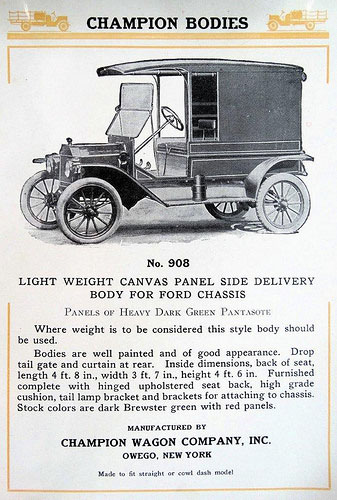For price and purchase, please click here… 

The Champion Wagon Company dates to 1888 when it was re-organized from the original firm going by the name of Gere, Truman, Platt & Company. Both firms built the same basic “Champion Wagon” with the unique steering system. In this design, both the front and rear axles have several important features. First, the front axle is engineered to allow only the wheels to turn while the axle remains fixed. It’s a technology that was truly distinctive on a farm style wagon and an idea that early automobiles capitalized on. However, with multiple patents on similar wagon and carriage technology dating at least as early as the mid 1850’s and 60’s, the roots of this system are firmly fixed in the horse drawn era.
One big advantage to this ‘auto-steer’ design is that it provides a more stable foundation for the box and load since the front axle and bolster are always aligned and in the same position, fully supporting the width of the box. The design was also touted as one that turns easier and tighter while simultaneously helping reduce the effects of the tongue whipping and jerking the horses on rough terrain. Also mimicked by early automobiles, both sets of bolsters and axles are equipped with coil-style springs to help dampen the shock of rough roads and uneven terrain.
– Wheels that Won the West *
The Champion Wagon Co, of Owego, NY, was well-known for its patented sprung wagon axles of 1889 (above). Their logo was ‘The Champion Wagon is the Horse’s Friend.’ The company was initially founded in 1888 (previously Gere, Truman, Platt & Co), and started manufacturing self-propelled electric commercial vehicles in 1902. In 1905 they marketed some smart-looking electric delivery vans and depot hacks. With the introduction of the Model T they started a series of small trucks built on Ford Model T chassis. In 1916 they offered a limited number of funeral coaches on chassis from Studebaker, Overland and Cadillac. A bankruptcy in 1913 and a bail-out in 1919 sealed their fate and the doors closed permanently in 1921.
The names of juvenile coaster wagons reflected those of leading adult size wagons and automobiles of the day – Champion was a leading wagon maker, with a wide distribution network and regular catalogues for wholesale and retail sales. So it made economic sense for the company to add children’s toys to their line of farm wagons, and this example would have been built as a promotion for the company’s full-size wagons.
This coaster wagon is very well made, with dovetailed joints, cast fittings and steel-banded wooden wheels. In common with early wagons, the axles are wooden rather than steel; both styles of axles were advertised by 1895. It is made in the style of the Champion horse wagon, rather than one of the new-fangled horseless carriages which ‘Champion Wagon Co’ went on to make at the turn of the century.
I’ve seen similar dovetailed joints on other coaster wagons of the 1880s-1890s; children’s toys of this type were expensive quality items only purchased by rich families. As a promotion for the company’s full-size wagons, it was important for it to reflect a high standard of manufacture. The cast fitting that joins the handle to the front axle is particularly ornate, reflecting the fact that the full-size Champion wagons had a unique patented front end – their primary selling point, as illustrated above.


1895 Champion Coaster Wagon
(Champion Wagon Co, Owego, NY)
LENGTH: 30″
12″ Front Wheels
16″ Rear Wheels

1880s/1890s juvenile wagons were previously underestimated by collectors of antique pedal cars because they were overshadowed by the first automobile toys that came out a decade later. But their genre has now been acknowledged, and those which can be identified to an individual manufacturer or retailer are snapped up promptly. They are particularly sought by those with an interest in the final days of America’s Wild West and the first days of the bicycle – the era before the automobile changed society forever.
The romance of the American west and its frontier life was far removed from its reality – harsh conditions and poverty – and It’s interesting to consider that this Champion coaster wagon, a miniature version of the full-size horse drawn wagons seen on American streets, was being sold to rich children’s families in American cities at a time when cowboys still operated in wilder parts of the country.







THE 1889 CHAMPION FARM WAGON CATALOGUE



UNDERSIDE OF THE CHAMPION COASTER WAGON








COASTER WAGON EVOLUTION: 1895 WOODEN CHAMPION v 1906 METAL IMPERIAL

Large rear wheels and smaller front wheels are found on most pre-1910 wagons and pedal cars. It’s interesting to see the evolution from wooden bodies and wheels to metal bodies and wheels in these two wagons.

TO SEE THE
1906 METAL IMPERIAL COASTER WAGON
PLEASE CLICK HERE

* http://wheelsthatwonthewest.blogspot.co.uk/2013/02/champion-wagon.html
http://www.coachbuilt.com/bui/c/champion/champion.htm



















